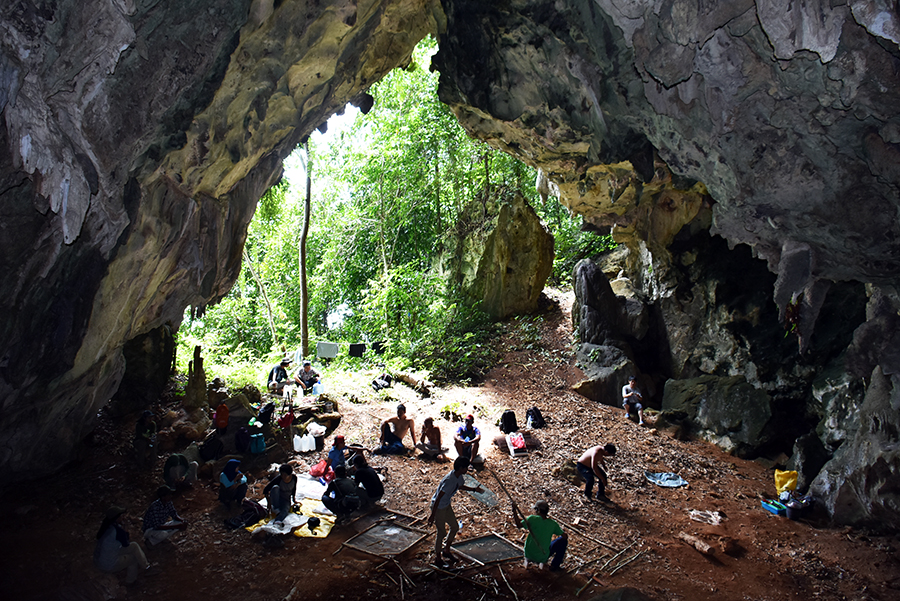Press Releases Archive
09.06.2022
Pre-historic Wallacea – a melting pot of human genetic ancestries
To shed light on the archipelago’s settlement history, researchers sequenced and analyzed sixteen ancient genomes
The Wallacean islands of present-day Eastern Indonesia have a long history of occupation by modern humans. Notably, the maritime expansion of Austronesian speakers into Wallacea left archaeological traces of a Neolithic lifestyle and a genetic imprint still detectable in Eastern Indonesians today. To gain further insights into Wallacea’s settlement history, an international team of scientists led by the Max Planck Institutes for Evolutionary Anthropology (Leipzig), the Science of Human History (Jena) and the Senckenberg Centre for Human Evolution and Palaeoenvironment at the University of Tübingen sequenced and analyzed 16 ancient genomes from different islands of Wallacea, finding evidence for repeated genetic admixtures starting at least 3,000 years ago. Those contacts involved multiple distinct groups from neighboring regions of Asia and Oceania.
The Wallacean islands have always been separated from Asia and Oceania by deep-sea waters. Yet, these tropical islands were a corridor for modern humans migrating into the Pleistocene Australia-New Guinea landmass (Sahul) and have been home to modern human groups for at least 47 thousand years. The archaeological record attests a major cultural transition across Wallacea that started around 3,500 years ago and is associated with the expansion of Austronesian-speaking farmers, who intermixed with local hunter-gatherer groups. However, previous genetic studies of modern-day inhabitants have yielded conflicting dates for this intermixing, ranging from 1,100 to nearly 5,000 years ago.
To shed light on the details of this expansion and the resulting human interactions, an international team of researchers analyzed DNA from 16 ancient individuals from different islands in Wallacea, greatly increasing the amount of ancient genomic data representing this region. “We found striking differences between regions in Wallacea and surprisingly, the ancestry of ancient individuals from the southern islands cannot be simply explained by admixture between Austronesian- and Papuan-related groups,” says Sandra Oliveira, one of the study’s lead authors.
Early ancestry contribution from Mainland Southeast Asia
The team identified an additional ancestry contribution from Mainland Southeast Asia, closest to present-day Austroasiatic speakers, and proposed that admixture occurred first between the Mainland Southeast Asian and Papuan-related ancestry and that gene flow from Austronesian-related groups occurred only later. “That Mainland Southeast Asian component is a great mystery to me. I suspect that we might be looking at small groups, perhaps of early farmers, who travelled a long way, left no archaeological or linguistic traces along the way, but who increased their population sizes after arrival," says Peter Bellwood, an author of the study who has conducted archaeological work in Island Southeast Asia for decades.
While the identity of the people who spread this ancestry is still unclear, the discovery of the Mainland Southeast Asian ancestry and its possible antiquity in the southern Wallacean islands has major implications for the understanding of the Neolithic dispersals into Island Southeast Asia. “This finding is very important for the archaeologists in the region,” adds co-author Toetik Koesbardiati, an anthropologist at the Universitay Airlangga in Indonesia. She adds, “We will certainly intensify our efforts to study this migration with other lines of evidence.”
Multiple admixture events throughout Wallacea
This work also revealed a closer relationship between the Austronesian-related ancestry of ancient individuals from northern Wallacea and the Pacific, compared to those from southern Wallacea – a pattern matched by linguistic evidence. Additionally, it shed light on the timing of the Asian-Papuan genetic admixture. “Previous studies based on present-day populations have reported widely different estimates, some of which preceded the archaeological evidence for the Austronesian expansion, while others were much more recent. Since we now have ancient individuals from different time periods we can directly show that admixture occurred in multiple pulses or continuously since at least 3,000 years ago throughout Wallacea,” explains Mark Stoneking, a senior author of the study. He adds, “Future studies on older genomes might extend this date even further.”
Local hunter-gatherers’ genetic ancestry was largely replaced
The team also searched for genetic similarities between the newly reported ancient Wallaceans and a previously published pre-Neolithic individual from Sulawesi, another island in Wallacea. “All Wallacean individuals sequenced in this study are more similar to present-day New Guinean groups than to the earlier local population, suggesting that these two regions were more closely connected in ancient times than previously imagined,” says Cosimo Posth, another senior author of the study. He concludes, “These results also confirm that the genetic ancestry of Wallacean hunter-gatherers has been largely replaced.”
Press release of the Max Planck Institute for Evolutionary Anthropology, the Senckenberg Nature Research Society and University of Tübingen
Publication:
Sandra Oliveira, Kathrin Nägele, Selina Carlhoff et al.
Ancient genomes from the last three millennia support multiple human dispersals into Wallacea
Nature Ecology & Evolution, 09 June 2022, DOI: 10.1038/s41559-022-01775-2
Contact
Dr. Sandra Oliveira
Max Planck Institute for Evolutionary Anthropology, Leipzig
Phone +49 341 3550-505
sandra_oliveiraspam prevention@eva.mpg.de
Prof. Dr. Mark Stoneking
Max Planck Institute for Evolutionary Anthropology, Leipzig
Stonekgspam prevention@eva.mpg.de
Prof. Dr. Cosimo Posth
University of Tübingen, Institute for Archaeological Sciences
Senckenberg Centre for Human Evolution and Palaeoenvironment
cosimo.posthspam prevention@uni-tuebingen.de
Contact for press:
Eberhard Karls Universität Tübingen
Public Relations Department
Dr. Karl Guido Rijkhoek
Director
Janna Eberhardt
Research Reporter
Telefon +49 7071 29-77853
Fax +49 7071 29-5566
janna.eberhardtspam prevention@uni-tuebingen.de
All press releases by the University of Tübingen
Back
